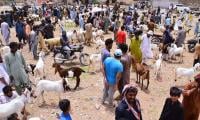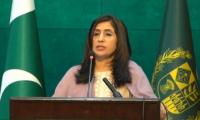SAINT-DENIS, FRANCE: Used to teaching 24 children or more at a time, Zahia Adnani now spends her days with a group around half that size in her colourful classroom north of Paris where a flagship effort to tackle inequality is under way.
Adnani´s Taos Amrouche school is in the high-immigration Paris suburb of Seine-Saint-Denis, home to the national sports stadium and Charles de Gaulle airport, as well as deep problems of poverty, crime and Islamism. Over decades, governments have launched plan after plan here focused on improving local infrastructure and housing, upgrading living conditions slowly in the area´s ghettos and their high-rise tower blocks.
Emmanuel Macron, the 40-year-old centrist president elected last May, wants a change of emphasis: while public investment will continue, he wants to focus efforts on improving early-age literacy to help bust the poverty trap.
When pupils returned to class last September, the government forced schools in high-priority zones, including many areas of Seine-Saint-Denis, to divide their classes into two for children aged six to seven. Instead of a maximum 24 pupils, there should be 12 or less per teacher. “I´m very positive about it,” Adnani says during a chat in the staffroom of her recently opened school, which stands among new low-rise residential blocks — signs of the investment going into the area. Around 2,500 classes nationwide are like hers, meaning roughly 30,000 children are benefiting from the special treatment. - Achievement gap - The aim is to correct one of the biggest failings of the French public education system: the gap in achievement between children from poor and wealthier backgrounds.
“I don´t feel like I lose children along the way,” Adnani said. “And you can spend more time with those pupils who advance quicker than the others.” As well as allowing more individualised teaching, smaller classes are easier to control — an advantage in an area like Seine-Saint-Denis where discipline problems are widespread.
From September, the initiative will be expanded in the same high-priority zones to a second school year, for pupils aged seven to eight, meaning 5,600 classes will take part. Education Minister Jean-Michel Blanquer is yet to unveil any results of the change, but he claims the feedback has been “more than excellent”. - ´Unbearable´ injustice - For Macron, who is married to his former school teacher Brigitte, the reform is about more than just education.
Ten months after his election, it remains his key social policy for deprived areas and a response to critics who see the ex-investment banker as a “president of the rich”, too focused on pro-business reforms.
It also backs up his public commitment to taking on inequalities.
“One thing is unbearable in a society,” Macron said in February. “It´s saying ´you are from a certain place so you don´t have the same access as the others. You don´t have the same opportunities to succeed´.” A child at a French school in a deprived area is four times more likely to end up struggling than their peers from higher income areas, the Organisation for Economic Co-operation and Development (OECD) has found.
On this measurement, France was the worst performing of 36 major economies measured by the respected Paris-based research institute, far behind Britain or the United States but also Brazil and Mexico.
“Not only do inequalities start at a very young age, but on top of that, investment in France has not been well targeted and is not balanced,” OECD education expert Eric Charbonnier told AFP.
Most countries spend more on primary education than on secondary schools. But not France. Investment per child in primary schools is 15 percent lower than the average in the OECD´s 35 members, which are mostly Western industrialised nations. At secondary level, investment is 37 percent higher than average.
Harvey Weinstein. — AFP FileNEW YORK: Harvey Weinstein’s 2020 conviction for sexual assault and rape was...
Liberal Justice Elena Kagan on Sept. 13, 2016. — Slate website WASHINGTON: U.S. Supreme Court justices, wading back...
A representational image of inmates behind jail bars. — Unsplash/FileMOSCOW: A Russian court on Wednesday ordered...
Sudanese soldiers guard the surrounding area of the UNMIS compound in El-Fasher, the administrative capital of North...
US quietly shipped ATACMS missiles to Ukraine. — Report news agencyWASHINGTON: The United States in recent weeks...
US President Joe Biden during his address in California. — AFP FileWASHINGTON: President Joe Biden signed a...







